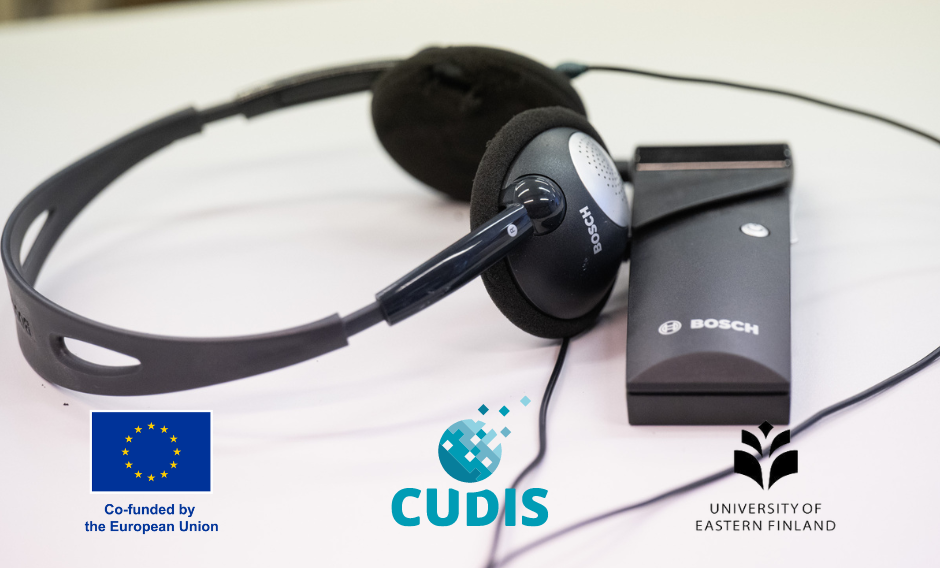Multilingual project – How we make it work

Our project operates in a multilingual and multicultural environment. International students and jobseekers are at the centre of our operations, so any kind of experimentation and brainstorming that promotes multilingual communication has been part of the project from the beginning. Although we primarily operate in English and Finnish, we have not excluded other languages. What have we tried and learned so far? Here is a brief overview of various solutions we have experimented with to promote accessibility.
Translation Apps
Translation apps are familiar to many in daily work especially for translating written text, but translating speech is likely less common. We tried speech translation during our training event using Teams live translated captions from Finnish to English. Teams generates captions in the desired language from the speaker’s speech, which are displayed on users’ computer screens. During our training, we projected the Teams view onto a screen so participants could follow the captions. The captions were generated quickly and were fairly understandable to the audience, although not perfect.
We found that when using the app, it is important to speak standard language at a reasonable pace and to clearly separate individual sentences. So, at least in this developmental stage, the app is not the most reliable option for situations involving casual conversation. Instead, formal texts such as instructions and presentations that are read directly from paper could translate quite well.
Translation apps like Google Translate were also used experimentally among participants in small groups during training events with different language pairs. These situations, where conversations were held using participants’ most fluent languages via translation apps, brought a refreshing change to discussions, as English, often used as a common language, is not everyone’s native language. However, challenges were encountered: informal language had to be avoided, the speech rhythm had to be appropriate, and some of the rarer languages were not available.
Interpretation
During one training session, we utilised professional interpreters to translate speeches from Finnish to English simultaneously. Simultaneous interpretation involves the interpreter translating while the speaker is speaking. This is a faster form of interpretation than consecutive interpretation. The University of Eastern Finland has interpretation booths, so arranging interpretation was quite convenient. Interpreters work in the booth, and audience members requiring interpretation listen through headphones. Interpreters understand meanings more clearly than machines and convey the spoken message accurately. They are not confused by colloquialisms or filler words, which can be challenging for translation apps.
What to consider? It is important to provide interpreters with information about the topics being discussed and their order in advance, for example, by sending them the speakers’ slides and the event schedule. It is also important to ensure that all equipment is functioning properly. Speakers should be advised to incorporate brief pauses into their speech to allow interpreters enough time to convey the entire message accurately.
What feedback did we receive? Interpretation sparked interest among our participants. For some, interpretation could be a career option, and for companies it could be a necessary service. Participants also asked interpreters many practical questions, for example about preparation. Some of the feedback concerned our equipment; our headphones were not sufficiently soundproof, so some found it distracting to hear both the speaker and the interpreter at the same time.
Next autumn, we will offer interpretation practice opportunities for students studying interpretation at UEF. In practice, this would mean interpreting short presentations in our training events (20-30 minutes) in 5–10 minute segments, alternating between two or three students. This way, students get practice in real interpretation situations, gaining work experience. At the same time, they can strengthen their networks with company representatives participating in the training.
Mixing Languages
As mentioned earlier, we have used Finnish and English as well as other languages simultaneously. We aim to provide written materials, such as instructions, both in Finnish and English, and in some cases in Swedish. To aid interpretation, we have requested materials from our speakers and trainers in English, even if the presentation language has been Finnish. This way, most of the participants can easily review the presentation materials afterwards.
During our training sessions, participants can converse and ask questions in any language the speakers mutually understand. We want to encourage a conversational and open atmosphere where expressing oneself is as easy as possible. We try to ensure that everyone is understood and that no one is left out of important discussions. Furthermore, the flexible atmosphere encourages participants to challenge their language skills.
We will continue these experiments as the project progresses and keep our minds open.
Thank you for reading.
– Oona Järvinen, project secretary